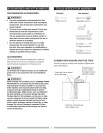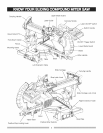
ELECTRICAL REQUIREMENTS - cont'd
DOUBLE INSULATED []
The power tool is double insulated to provide a double
thickness of insulation between you and tool's electrical
system. All exposed metal parts are isolated from
the internal metal motor components with protecting
insulation:
Replacement parts - When servicing use only identical
replacement parts.
Polarized plugs = This saw has a plug that looks like
the one shown below:
To reduce the risk of electrical shock, this saw has a
polarized plug (one blade is wider than the other). This
plug will fit in a polarized outlet only one way. If the plug
does not fit fully in the outlet, reverse the plug. If it still
does not fit, contact a qualified electrician to install the
proper outlet. Do not change the plug in any way.
4. FUSES may "blow" or circuit breakers may trip
frequently if:
a. MOTOR is overloaded - overloading can occur if
you feed too rapidly or make too many start/stops
in a short time.
b. LINE VOLTAGE is more than 10% above or
below the nameplate voltage rating. For heavy
loads, the voltage at motor terminals must equal
the voltage specified on the nameplate.
c. IMPROPER or dull saw blades are used.
5. Most motor troubles may be traced to loose or
incorrect connections, overload, low voltage or
inadequate power supply wiring. Always check the
connections, the load and supply circuit if the motor
doesn't run well. Check minimum gauge for the
length of cord you are using on the chart below.
GUIDELINES FOR EXTENSION CORDS
Use a proper extension cord Make sure your
extension cord is in good condition. When using an
extension cord, be sure to use one hea W enough to
carp/the current your product will draw. An undersized
cord will cause a drop in line voltage, resulting in loss of
power and cause overheating. The table below shows
the correct size to use depending on cord length and
nameplate ampere rating. If in doubt, use the next
heavier gauge. The smaller the gauge number, the
heavier the cord.
[A WARNINGI
Double insulation does not take the place of normal
safety precautions when operating this tool.
To avoid electrocution:
1. Use only identical replacement parts when
servicing a tool with double insulation. Servicing
should be performed by a qualified technician.
2. Do not use power tools in wet or damp locations
or expose them to rain or snow.
MOTOR SAFETY PROTECTION
IMPORTANT:
To avoid motor damage, the motor should be blown out
or vacuumed frequently to keep sawdust from interfering
with the motor ventilation.
1. CONNECT this saw to a 120 V, 15 A circuit with a 15
A time-delay fuse or circdt breaker. Using the wrong
size fuse can damage the motor.
2. If the motor won't start, release the trigger switch
immediately. UNPLUG THE SAW. Check the saw
blade to make sure it turns freely. If the blade is free,
try to start the saw again. If the motor still does not
start, refer to the TROUBLESHOOTING GUIDE.
3. If the tool suddenly stalls while cutting wood, release
the trigger switch, unplug the tool, and free the blade
from the wood. The saw may now be started and the
cut finished.
Be sure your extension cord is properly wired and
in good condition. Always replace a damaged extension
cord or have it repaired by a qualified person before
using it. Protect your extension cords from sharp
objects, excessive heat and damp or wet areas.
Use a separate electrical circuit for your tools. This
circuit must not be less than a #I 2 wire with a 20 A
time-lag fuse or a #14 wire with a 15 A time-lag fuse.
NOTE: When using an extension cord on a circuit with
a # 14 wire, the extension cord must not exceed 25 feet
in length. Before connecting the tool to the power line,
make sure the switch is in the OFF position and the
electric current is rated the same as the current stamped
on the motor nameplate, running at a lower voltage will
damage the motor.
• _ = e = = Q O=lJ =
(When usng 120 volts only)
Ampere Rating Total length of Cord
MoreThan NotMoreThan 25ft. 50ft. 100ft. 150ft.
0 6 18 16 16 14
6 10 18 16 14 12
10 12 16 16 14 12
CAUTION: In all cases make certain the receptacle in
question is properly grounded. If you are not sure,
have a certified electrician check the receptacle.
5


















